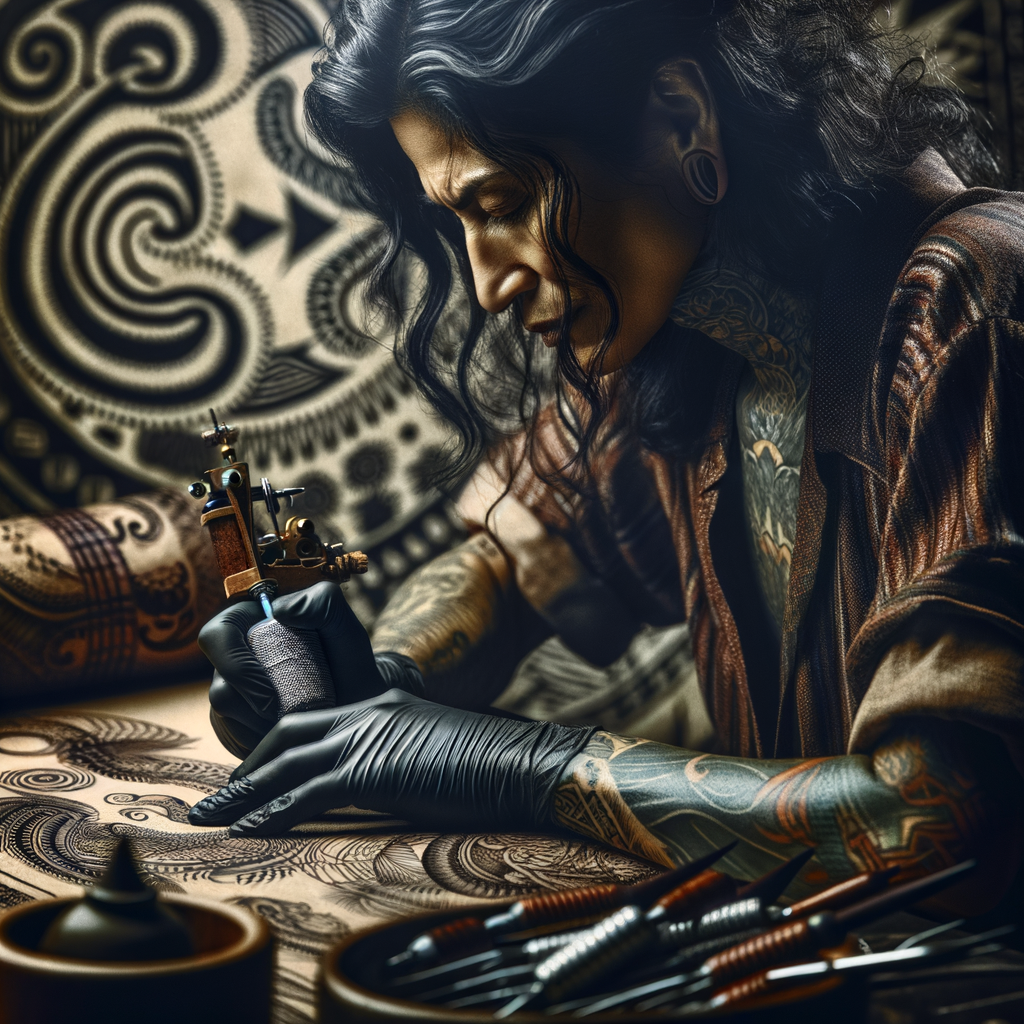
Introduction to Traditional Tattooing
Welcome to the fascinating world of traditional tattooing. This art form has been around for centuries, and it’s more than just a way to decorate the body. It’s a form of expression, a rite of passage, and a way to tell a story. Let’s dive in and learn more about this ancient craft.
-
- Understanding the Art of Traditional Tattooing
Traditional tattooing is a unique art form that requires skill, patience, and a deep understanding of cultural symbolism. Unlike modern tattooing methods, traditional tattooing often involves hand tools instead of machines. This method, known as “hand poking,” gives traditional tattoos their distinctive look.
Each tattoo is a work of art, carefully crafted to tell a story or represent a belief. The symbols used in traditional tattoos often have deep cultural significance. For example, in Polynesian cultures, a tattoo might tell the story of a person’s ancestry or achievements.
-
- The Importance of Tattoo Craftsmanship
Tattoo craftsmanship is of utmost importance in traditional tattooing. A well-crafted tattoo not only looks beautiful but also lasts longer. The tattoo artist must have a steady hand and a keen eye for detail. They must also understand the symbolism behind the designs they are creating.
Good craftsmanship also involves safety and hygiene. The artist must ensure that all tools are clean and sterile to prevent infection. They must also know how to care for a new tattoo to ensure it heals properly and maintains its vibrant colors.
In conclusion, traditional tattooing is a rich and complex art form that combines skill, cultural knowledge, and a deep respect for the human body. As we explore the history, methods, and design techniques of traditional tattooing, we’ll gain a deeper appreciation for this ancient craft.
History of Tattoos
Let’s delve into the fascinating history of tattoos, exploring their early beginnings and how they have evolved over the centuries.
-
- Early Beginnings of Tattoo Artistry
The art of tattooing has a rich and diverse history that dates back thousands of years. The oldest known tattooed human skin to date is found on the body of Otzi the Iceman, who lived around 5,300 years ago. His body, discovered in the Alps, had 61 tattoos across it. These tattoos were not for decoration but were likely therapeutic or symbolic.
Across the globe, from ancient Egypt to Polynesia, tattoos were used for a variety of reasons. They served as symbols of religious devotion, rites of passage, and marks of status or punishment. In some cultures, tattoos were believed to provide protection against evil spirits or bring good luck.
-
- Evolution of Tattoo Techniques Over the Centuries
Over the centuries, the techniques used for tattooing have evolved significantly. In the beginning, tattoos were created by cutting designs into the skin and rubbing ink, ashes, or other agents into the wounds. This process was painful and often led to infection.
Over time, people started using a variety of tools to make the process easier and safer. The Maori people of New Zealand, for example, used chisels made of bone to carve intricate designs into the skin. In Japan, tattoo artists used a method called Tebori, where a bundle of needles attached to a wooden handle was used to hand-poke the ink into the skin.
In the late 19th century, the first electric tattoo machine was invented, revolutionizing the tattoo industry. This machine made the process faster, less painful, and allowed for more detailed and intricate designs. Today, tattoo artists use a variety of techniques and tools, from traditional methods to state-of-the-art machines, to create stunning pieces of body art.
Case Study: Ancient Tattoo Techniques
As we delve into the history of tattoos, it’s fascinating to uncover the ancient techniques that were used. These methods, often rooted in cultural practices, have had a profound impact on modern tattoo designs.
-
- Exploring Ancient Tattooing Skills
Long before the invention of tattoo machines, our ancestors were creating intricate designs on their skin. They used tools made from bone, wood, and metal, and ink derived from natural sources like charcoal and plant dyes.
One of the oldest known techniques is ‘hand poking’, where a needle attached to a stick was dipped in ink and then pushed into the skin. This method required great skill and patience, as each dot of the design had to be individually created.
Another ancient method was ‘skin cutting’. In this process, a design was cut into the skin with a sharp tool, and then ink was rubbed into the wound. This technique created a raised tattoo, giving a unique texture to the design.
-
- Impact of Cultural Tattoo Practices on Modern Designs
Many of the tattoo designs we see today have their roots in ancient cultures. For instance, tribal tattoos, which are popular for their bold and intricate patterns, originated from indigenous tribes who used tattoos as a form of identity and status symbol.
Similarly, the Japanese Irezumi style, known for its large, colorful designs often covering an entire arm or leg, has its origins in the Edo period of Japan. These designs typically feature elements from Japanese folklore and mythology.
Even the modern trend of minimalist tattoos, featuring simple lines and shapes, can be traced back to ancient cultures. For example, the ancient Egyptians used simple geometric designs to represent concepts like eternity and protection.
In conclusion, the ancient tattoo techniques and their cultural significance have greatly influenced the tattoo designs we see today. As we continue to innovate and evolve, these ancient practices will always remain at the heart of tattoo artistry.
Traditional Tattoo Methods
Let’s dive into the fascinating world of traditional tattoo methods and understand how they differ from modern techniques.
-
Overview of Traditional Tattoo Methods
Traditional tattoo methods, often referred to as ‘hand-poked’ or ‘stick and poke’ tattoos, have been practiced for thousands of years across various cultures. Unlike modern tattooing that uses electric machines, traditional methods involve manually inserting ink into the skin using a needle attached to a stick.
Some of the most well-known traditional tattoo methods include:
- Tebori: Originating from Japan, this method involves using a rod made from either metal or wood with a set of needles at the end.
- Ta Moko: This Maori tattooing technique from New Zealand uses chisels made of bone, shell, or metal.
- Sak Yant: A spiritual form of tattooing from Thailand that uses a long bamboo stick with a needle at the end.
-
Key Differences Between Traditional and Modern Tattoo Techniques
While both traditional and modern tattoo methods result in beautiful and meaningful body art, they differ in several ways:
Aspect Traditional Tattooing Modern Tattooing Tools Handmade tools like sticks, bones, or shells Electric tattoo machines Process Manual insertion of ink Automated insertion of ink Time Can take longer due to manual process Generally quicker due to automation Pain Level Can be more painful Less painful due to faster process Despite these differences, the choice between traditional and modern tattoo methods ultimately depends on personal preference, desired aesthetic, and cultural significance.
Tattooing Skills
Mastering the art of traditional tattooing requires a unique set of skills. These skills are not only essential for creating beautiful tattoos but also for ensuring the safety and satisfaction of your clients. Let’s explore these skills and how you can develop and refine them.
-
- Essential skills for traditional tattooing
There are several key skills that every traditional tattoo artist should possess:
-
-
- Artistic Ability: This is the foundation of tattooing. You need to be able to draw and design unique tattoos that meet your clients’ expectations.
- Steady Hand: Tattooing requires precision. A steady hand ensures that the tattoo is applied correctly and looks professional.
- Knowledge of Safety Procedures: Tattooing involves breaking the skin, so it’s critical to understand and follow safety procedures to prevent infections.
- Patience: Tattooing can be a lengthy process, requiring patience both in applying the tattoo and in dealing with clients.
- People Skills: As a tattoo artist, you’ll be working closely with clients. Good people skills can help you understand their needs and make them feel comfortable.
- How to develop and refine tattooing skills
-
Developing and refining your tattooing skills takes time and practice. Here are some tips:
-
- Practice Drawing: The more you draw, the better your artistic skills will become. Try different styles and techniques to expand your abilities.
- Get Professional Training: Consider enrolling in a professional tattooing course. This can provide you with the technical skills and knowledge you need.
- Learn From Others: Look for opportunities to learn from experienced tattoo artists. This could be through an apprenticeship or by attending industry events.
- Keep Up with Trends: Tattoo styles and techniques can change over time. Staying up-to-date with the latest trends can help you stay relevant and meet your clients’ needs.
- Practice Safety: Always prioritize safety. This includes maintaining a clean workspace and following proper sterilization procedures.
Remember, becoming a skilled tattoo artist takes time and dedication. But with patience, practice, and a commitment to learning, you can master the art of traditional tattooing.
Tattoo Design Techniques
Designing a tattoo is a complex process that requires a deep understanding of art and technique. In this section, we will delve into the process of creating a tattoo design and explore different tattoo design techniques.
-
- Understanding the Process of Creating a Tattoo Design
Creating a tattoo design is a multi-step process that begins with an idea. The artist then sketches the design, refines it, and finally, transfers it onto the skin using a special stencil. The design is then traced with a tattoo machine, which injects ink into the skin.
It’s important to remember that each tattoo is unique and the design process can vary greatly depending on the artist’s style and the client’s preferences.
-
- Exploring Different Tattoo Design Techniques
There are many different techniques that tattoo artists use to create their designs. Here are a few examples:
-
-
- Line work: This technique involves creating a design using only lines. It requires a steady hand and a lot of precision.
- Shading: Shading is used to add depth and dimension to a tattoo. It can be done in black and grey or color.
- Color blocking: This technique involves filling in large areas of a design with solid color. It’s often used in traditional and neo-traditional tattoos.
-
These techniques can be used individually or combined to create a wide variety of designs. The choice of technique often depends on the style of the tattoo and the artist’s personal preference.
Art of Traditional Tattooing
The art of traditional tattooing is a fascinating world that combines creativity, skill, and cultural significance. Let’s delve into its key elements and learn how to appreciate and critique this unique form of artistry.
-
- Key Elements of the Art of Traditional Tattooing
Traditional tattooing is more than just ink on skin. It’s a form of self-expression that tells a story, often deeply rooted in cultural or personal symbolism. Here are some key elements that make up this art form:
| Element | Description |
|---|---|
| Design | The design is the visual representation of the story or message the tattoo is conveying. It can range from simple symbols to intricate scenes. |
| Color | Color can add depth and emotion to a tattoo. Traditional tattoos often use bold, vibrant colors. |
| Placement | The placement of a tattoo can hold significance. It can also affect the visibility and impact of the design. |
| Technique | The technique used can influence the look and feel of the tattoo. Traditional methods often involve hand-poking or tapping. |
-
- How to Appreciate and Critique Tattoo Artistry
Appreciating and critiquing tattoo artistry involves understanding the elements mentioned above and how they work together to create a cohesive piece. Here are some tips:
-
- Look at the overall design: Is it visually appealing? Does it tell a story or convey a message?
- Consider the use of color: Do the colors complement each other? Do they add depth and emotion to the design?
- Examine the placement: Is the tattoo placed in a way that enhances its visibility and impact?
- Assess the technique: Is the tattoo well-executed? Are the lines clean and the shading smooth?
Remember, art is subjective. What one person may find beautiful, another may not. The most important thing is to respect the artistry and the personal expression it represents.
Conclusion: The Future of Traditional Tattooing
As we wrap up our exploration of traditional tattooing, it’s important to look ahead. What does the future hold for this ancient art form? Let’s delve into the current trends and predictions for the future of tattoo techniques.
- Current trends in traditional tattooing
Traditional tattooing is experiencing a resurgence in popularity. People are increasingly drawn to the authenticity and cultural significance of these designs. The bold lines and vibrant colors of traditional tattoos are making a comeback, with many tattoo enthusiasts opting for these over more modern styles.
Moreover, there’s a growing appreciation for the skills and techniques involved in traditional tattooing. Artists who specialize in this style are in high demand, as they bring a unique touch to their work that can’t be replicated by machines.
- Predictions for the future of tattoo techniques
Looking ahead, we can expect to see even more innovation in traditional tattooing techniques. Artists are constantly pushing the boundaries of what’s possible, experimenting with new tools and methods to create stunning works of art.
One prediction is that we’ll see a blending of old and new. Artists may start incorporating modern technology into traditional techniques, creating a hybrid style that’s both fresh and rooted in history.
Another prediction is that there will be a greater focus on sustainability. As people become more conscious of their impact on the environment, they’ll seek out artists who use eco-friendly inks and materials.
Lastly, we can expect traditional tattooing to continue gaining recognition as a legitimate art form. This means more exhibitions, more scholarly research, and more opportunities for artists to showcase their work on a global stage.
In conclusion, the future of traditional tattooing looks bright. As we move forward, it’s exciting to think about the new trends and techniques that will shape this ever-evolving art form.






